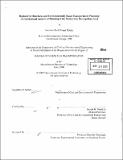| dc.contributor.advisor | Joseph M. Sussman. | en_US |
| dc.contributor.author | Makler, Jonathan Todd Nappi, 1977- | en_US |
| dc.contributor.other | Massachusetts Institute of Technology. Dept. of Civil and Environmental Engineering. | en_US |
| dc.date.accessioned | 2005-09-27T19:54:13Z | |
| dc.date.available | 2005-09-27T19:54:13Z | |
| dc.date.copyright | 2000 | en_US |
| dc.date.issued | 2000 | en_US |
| dc.identifier.uri | http://hdl.handle.net/1721.1/9010 | |
| dc.description | Thesis (S.M.)--Massachusetts Institute of Technology, Dept. of Civil and Environmental Engineering, 2000. | en_US |
| dc.description | Includes bibliographical references (p. 217-219). | en_US |
| dc.description.abstract | This thesis presents research motivated by three critical issues. First, the rapid penetration of information technologies has changed the face of both transportation system management and long-term planning. Second, the federal mandate for integrated environmentally-based transportation planning in the United States was expanded with firm resolve by the Intermodal Surface Transportation Efficiency Act (ISTEA). Third, ongoing research work on the air quality problem in Mexico City demands in-depth attention to the management and planning of that metropolitan region's transportation system because of the important contribution of mobile sources to the air pollution problem. The purpose of this thesis is to expand an established theoretical framework that addresses the issue of data-intensive integrated management to include the relationship between transportation and environmental planning. The theoretical product of that endeavor, namely the Regional Planning Architecture framework, is tested in the context of Mexico City, in which the mobility and environmental problems are more extensive than in any city in the United States. The result of this work is a new Regional Planning Architecture (RPA) framework to accompany the previously established Regional Service Architecture. The RPA describes the fundamental institutional relationships that surround the production and implementation of short- and longterm transportation plans. The architecture reflects the need to integrate transportation and environmental plans by incorporating the relationships between transportation and environmental planners. This is particularly important in the area of conformity planning, which was brought about by ISTEA in 1991. Initially based on the specific requirements of U.S. legislation, the use of the Mexico City case study leads to an independent platform that helps to produce original recommendations for improvement in that city's mobility and environmental systems. The analysis suggests that in using regional architectures as a diagnostic or prescriptive tool, one should emphasize five elements of interaction among institutions: goals, ideas/needs, funding, approval, and data. The focus on goals reflects the finding that the formulation and exchange of goal statements can help planners comprehend and incorporate the goals of their colleagues from other agencies. Funding and emissions constraints facilitate the application of goals in the prioritization/approval process. The sharing of data and ideas/needs reflects the increasing availability of information to planners on the effectiveness of prior strategies and investments. | en_US |
| dc.description.statementofresponsibility | by Jonathan Todd Nappi Makler. | en_US |
| dc.format.extent | 223 p. | en_US |
| dc.format.extent | 16900180 bytes | |
| dc.format.extent | 16899937 bytes | |
| dc.format.mimetype | application/pdf | |
| dc.format.mimetype | application/pdf | |
| dc.language.iso | eng | en_US |
| dc.publisher | Massachusetts Institute of Technology | en_US |
| dc.rights | M.I.T. theses are protected by copyright. They may be viewed from this source for any purpose, but reproduction or distribution in any format is prohibited without written permission. See provided URL for inquiries about permission. | en_US |
| dc.rights.uri | http://dspace.mit.edu/handle/1721.1/7582 | |
| dc.subject | Civil and Environmental Engineering. | en_US |
| dc.title | Regional architectures and environmentally-based transportation planning : an institutional analysis of planning in the Mexico City Metropolitan Area | en_US |
| dc.type | Thesis | en_US |
| dc.description.degree | S.M. | en_US |
| dc.contributor.department | Massachusetts Institute of Technology. Department of Civil and Environmental Engineering | |
| dc.identifier.oclc | 47628512 | en_US |
